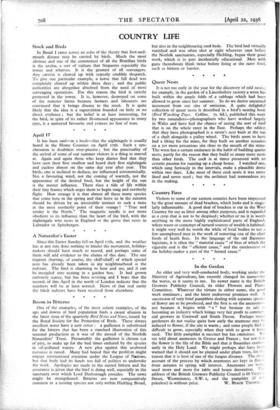One of the examples, of the most salient examples, of
the ups and downs of bird population finds a casual allusion in the latest issue of the quarterly Bird Notes and News, issued by the Royal Society for the Protection of Birds. These always excellent notes have a new cover : a guillemot is substituted for the bittern that has been a standard illustration of this seasonal production as it was of the annual of the Norfolk Naturalists' Trust. Presumably the guillemot is chosen out of pity, to make up for the bad times endured by the species in oil-polluted waters. A new plea against this unabated nuisance is raised. Many had hoped that the problem might engage international attention under the League of Nations, but that body had its hands too full of politics to undertake the work. Apologies are made to the ousted bittern and the assurance is given that the bird is doing well, especially in the sanctuary over which Lord Desborough presides. The news might be strengthened. Bitterns are now comparatively common as a nesting species not only within Hickling Broad, but also in the neighbouring reed beds. The bird had virtually vanished and was often shot at sight wherever seen before the Norfolk sanctuaries, especially Hickling, began their good work, which is in part incidentally educational. Men with guns thereabouts think twice before firing at the rarer fowl, such as bittern or harrier.










































 Previous page
Previous page